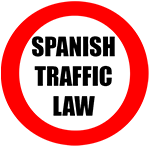1. Pedestrians are obliged to use pavements and pedestrian zone, except when there isn’t one or it is not practical; in such cases, they may use the hard shoulder or, failing that, the roadway, in accordance with the rules that are determined in this chapter (article 49.1 of the articulated text).
In these images you can clearly see the difference between using the reflective vest or not. The vest makes us more visible to other users. This allows approaching vehicles to see us better, thus enabling them to reduce speed, and leave sufficient space so that overtaking can be made safely. It is advisable to use it, both day and night.
2. However, even if there is a pedestrian zone, provided that the necessary precautions are taken, the following may use the hard shoulder or, if it does not exist or is not passable, the road:
A) Someone who carries a bulky object or pushes or drives a small vehicle that does not have an engine, if its movement in the pedestrian zone or on the hard shoulder could be a significant hindrance to other pedestrians.

B) Any pedestrian group led by a person or forming a procession.

C) A disabled person who travels in a wheelchair with or without a motor, at walking pace.
3. All pedestrians must travel on the pavement on the right-hand side in relation to the direction of their movement, and when they move on the pavement or left-hand-side they should always give way to those around them and should not stop in a way that prevents others from passing them, unless it is inevitable in order to cross a pedestrian crossing or board a vehicle.
If the street or road you are walking on does not have a pavement or hard shoulder, you should pass as close as possible to the wall or the edge, and if possible facing the traffic, in this way you can see the approaching vehicles in front of you. Nowadays there are many distractions at the wheel, and unfortunately, sometimes vehicles partially or fully invade the hard shoulder.
To walk facing oncoming vehicles will allow us to have a longer reaction time in case that, for some reason, a vehicle invades the area where we are walking. Remember that you cannot use the hard shoulder of a road if there is a nearby pedestrian area, which is in good condition.
4. Those who use skateboards, roller skates or similar devices that can’t travel on the road, except in the case of dedicated zones, roads or parts of roads that are specially designed for them, can only move at walking pace on pavements or residential streets duly indicated with the sign regulated in article 159, without under any circumstances being allowed to be towed by other vehicles.
Remember that on the road, their use is strictly prohibited, and in the pedestrian zones of the city, if they are not prohibited by the municipal rules of the city, they can only be used at a speed comparable to a person’s pace. Keep in mind, that if you are going to use them at night and you have to use them in the street, if they do not have the corresponding luminous signs at the front and back, then you will not be able to use them on public roads.
5. The movement of all types of vehicles must not, under any circumstances, be carried out on pavements and other pedestrian areas.
Ask the Local Police of your municipality about the legislation regarding the vehicle that you intend to use on public roads such as an electric scooter, scooter, segway … The City Councils are beginning to regulate the use of these new gadgets on their public roads, so it is advisable to inform yourself of its restrictions or limitations of use before using it.







